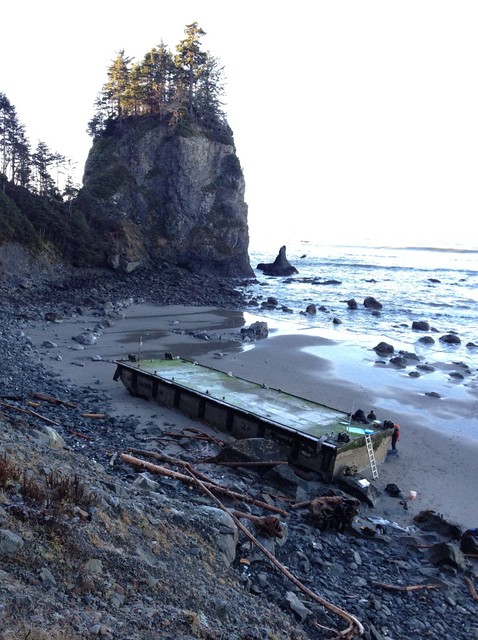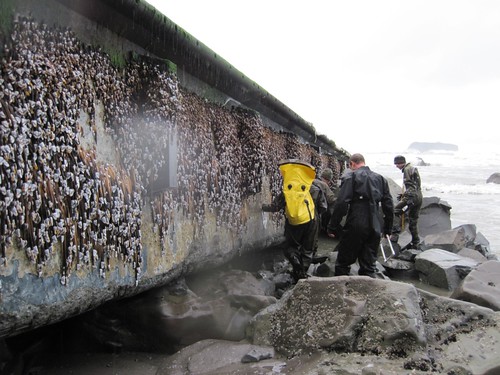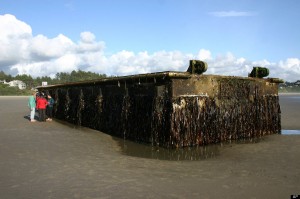
Japanese officials estimate that 5 million tons of Japan Tsunami Marine Debris (JTMD) washed into the Pacific after the March 11, 2011, earthquake and tsunami, according to the National Oceanic and Atmospheric Administration (NOAA). About 70% of that sank, leaving about 1.5 million tons floating. Scientists expect more debris to hit Alaska and the West Coast of North America for years to come.
UPDATED December 18, 2018
Articles of interest:
CNN news article 13 DEC 2018 about a barred knifejaw.
Oregon Public Broadcasting article 29 SEP 2017.
Hakai magazine article 21 OCT 2015.
Invasive species from Asia continue to arrive on tsunami marine debris (1/5/2015)
Marine debris continues to arrive on the shore of the Pacific northwest. As many as 30 small boats made the journey across the Pacific Ocean, and many had foreign passengers such as Japanese bat stars and even fish. See this December 28, 2014 article for details.
NOAA declares tsunami waste a “severe marine debris event” (2/15/13)
As tsunami waste continues to bob toward Oregon and West Coast shorelines, NOAA has declared a “severe marine debris event” that could streamline responses and clarify the federal government’s role in cleaning up the waste.The decision should clarify lines of authority and provide a better and more unified response to tons of waste from the 2011 Japanese earthquake and tsunami that is slowly relentlessly closing in on the Northwest coast. Scientists predict that the bulk of the waste will arrive between 2013 and 2015.
Crews haul tsunami debris off Oregon beach (2/7/13)
Workers pulled a 1-ton boat from the sand in early February 2013, and disposed of the debris in a landfill.
Biologists took samples of sea life found on the boat. The 27-foot vessel is believed to be debris from the March 2011 tsunami that hit Japan.
That theory got a boost when crews found a safety warning written in Japanese afixed to the boat.
Biologists Steve Rumrill and Justin Ainsworth with the Oregon Department of Fish and Wildlife inspected the boat, collected samples to identify the species, and gave clearance to Oregon Parks and Recreation Department staff to remove the debris.
The boat was about 200 yards from a beach access. Drayton Excavation out of Lincoln City used a piece of heavy equipment to excavate the debris and haul it off the beach.
NOAA confirms 20 cases of tsunami debris (1/23/13)
The National Oceanic and Atmospheric Administration has received 1,479 official debris reports, of which about 20 items have been confirmed tsunami debris.
Following the tsunami that struck the northern coast of Japan in March 2011, more than 5 million tons of debris and materials were washed away into the Pacific Ocean. With 1.5 million tons still at sea, debris is expected to continue to wash up on the west coast of the United States for the next decade.
Japan confirms dock beached on Washington coast is one of its own (1/17/13)

A large ocean-drifting dock that washed ashore in an extremely rugged and remote section of coast in the Olympic National Park was found Dec. 18 after an extensive helicopter search by the U.S. Coast Guard. As a precaution, a tracking buoy was attached to the dock, which was suspected to have been set adrift by the March 2011 Japanese tsunami, and indeed has since been confirmed by the Japanese government as of January 17, 2013. The dock is located within the Olympic Coast National Marine Sanctuary and within a designated wilderness portion of Olympic National Park. Resource protection and visitor safety are fundamental to the mission of both agencies, so the dock will be removed.The dock weighs about 185 tons and is 65 feet long, 20 feet wide and 7.5 feet tall. Although the dock has stayed in the same general location since its arrival on the beach, it is still quite mobile in the surf. As changing tides and waves continue to shift and move the dock, the dock will continue to batter the coastline, creating a hazard for visitors and wildlife and damaging both the coastal environment and the dock. The intertidal area of the Olympic Coast is home to the most diverse ecosystem of marine invertebrates and seaweeds on the west coast of North America.
Most of the dock’s volume is Styrofoam-type material, which is encased in steel reinforced concrete. The concrete has already been damaged, exposing rebar and releasing foam into the ocean and onto the beach where it can potentially be ingested by fish, birds and marine mammals. Leaving the dock in place could result in the release of over 200 cubic yards of foam into federally protected waters and wilderness coast.
Staff from the Olympic National Park and Washington Department of Fish and Wildlife finished removing invasive species from the dock in early January 2013. Initial lab results have identified 67 plant and animal species, most being native to Japan and not found in the United States. An updated species list can be found here.
UPDATED October 2012

Verified reports of tsunami debris on the U.S. west coast:
2/6/13: Crews haul tsunami debris off Oregon beach
1/22/13: Japan confirms dock beached on Washington coast is one of its own
Verified reports of tsunami debris elsewhere in the U.S.:
2/19/13: Kauai residents report spike in tsunami debris
2/18/13: Boat among latest confirmed tsunami debris to hit Hawaii
2/18/13: Tsunami Debris Litters Alaska Coast; Clean Up Funds Insufficient
2/4/13: Tsunami Debris On Alaska’s Shores Like ‘Standing In Landfill’
Additional Information and Federal Response Efforts
To learn more about the tsunami debris, NOAA researchers have been working with the U.S. Environmental Protection Agency, U.S. Fish and Wildlife Service, and other partners to coordinate data collection activities. NOAA and its partners are also coordinating an interagency assessment and response plan to address the wide-range of potential scenarios and threats posed by the debris.“We’re preparing for the best and worst case scenarios — and everything in between,” says Nancy Wallace, director for NOAA’s Marine Debris Program.
As the tsunami surge receded, it washed Japanese boats, pieces of smashed buildings, appliances, and plastic, metal, and rubber objects of all shapes and sizes washed into the Japan Sea. Some of the debris sank near shore and some continued to float into the Pacific Ocean. Large, floating debris fields were detected by satellite imagery and aerial photos of Japanese coastal waters.
The Japanese government estimated that the tsunami generated 25 million tons of rubble on land, but there is no clear understanding of exactly how much debris was swept into the water nor what remained afloat.
To learn more about efforts to track the Japanese marine debris, go to to the NOS site.
Help wanted: beachcombers and monitors
No matter where it comes from, we should all take comfort in this: debris is – for the most part – removable and preventable. If you see small debris, pick it up and examine it. Items that have no identifying markers should be disposed of properly, but if it belongs to someone, alert a local authority. You can also report large volumes of debris or items that clearly came from Japan to DisasterDebris@noaa.gov. There are other easy ways to help: join a beach cleanup or recommit yourself to recycling.
Some items should be left to the authorities. We urge beach cleaners not to touch anything that appears hazardous or too large to move safely. Report it, and it will likely be dealt with by local emergency responders.
This is a challenging situation, to be sure, and it will take everyone working together to address it. But if we remain aware and take action, we can reduce the impact marine debris has on our environment now and in the future – whatever it may bring. NOAA needs beach monitors to help us survey the shores for baseline marine debris data. That way, if more debris starts appearing, we’ll know the leading edge of the tsunami debris may have arrived. You can request NOAA Marine Debris Program protocols at MD.monitoring@noaa.gov.
To see a movie that models movement of the debris, click here.
To see daily tracks of where the debris should be, click here.
West Coast Leaders announce joint response to Japanese tsunami debris, see press release here.
Helpful Links
- Tsunami Debris Website – NOAA Marine Debris Program <http://marinedebris.noaa.gov/tsunamidebris/>
- Japan Tsunami Marine Debris Joint Information Center <http://disasterdebris.wordpress.com/>
- Tsunami Debris Website – NOAA National Ocean Service <http://oceanservice.noaa.gov/news/features/dec11/japan-tsunami-debris.html>
- Tsunami Marine Debris – An Expert Prospective <http://marinedebrisblog.wordpress.com/2012/02/16/one-year-later-japan-tsunami-aftermath-and-debris/>
- Marine Debris Blog – NOAA Marine Debris Program <http://marinedebrisblog.wordpress.com/>
